
Mamenchisaurus is a genus of sauropod dinosaur known for their remarkably long necks which made up nearly half the total body length. Numerous species have been assigned to the genus; however, the validity of these assignments has been questioned. Fossils have been found in the Sichuan Basin and Yunnan Province in China. Several species from the Upper Shaximiao Formation, whose geologic age is uncertain, have been described. However, evidence suggests this formation to be no earlier than the Oxfordian stage of the Late Jurassic. M. sinocanadorum dates to the Oxfordian stage, and M. anyuensis to the Aptian stage of the Early Cretaceous. Most species were medium-large to large sauropods, measuring roughly 15 to 26 meters in length—possibly up to 35 meters (115 ft), based on two undescribed vertebrae.

Yangchuanosaurus is an extinct genus of metriacanthosaurid theropod dinosaur that lived in China from the Middle Jurassic to Early Cretaceous periods, and was similar in size and appearance to its North American and European relative, Allosaurus. Yangchuanosaurus hails from the Upper Shaximiao Formation and Suining Formation and was the largest predator in a landscape that included the sauropods Mamenchisaurus and Omeisaurus and the stegosaurs Chialingosaurus, Tuojiangosaurus and Chungkingosaurus. This theropod was named after the area in which was discovered, Yongchuan, in China.
Xiaosaurus, is a genus of small herbivorous dinosaur from the middle Jurassic, approximately 169 to 163.5 mya. Xiaosaurus lived in what is now the Sichuan Basin of China.
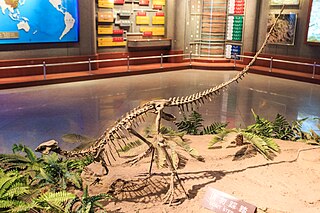
Agilisaurus is a genus of ornithischian dinosaur from the Middle Jurassic Period of what is now eastern Asia. It was about 3.5–4 ft long, 2 ft in height and 40 kg in weight.
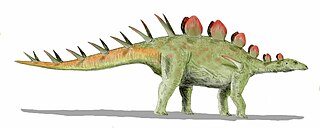
Chialingosaurus is a genus of herbivorous stegosaurian dinosaur similar to Kentrosaurus from the Upper Shaximiao Formation, Late Jurassic beds in Sichuan Province in China. Its age makes it one of the oldest species of stegosaurs, living about 160 million years ago. Since it was an herbivore, scientists think that Chialingosaurus probably ate ferns and cycads, which were plentiful during the period when Chialingosaurus was alive.

Crichtonsaurus is a genus of herbivorous ankylosaurid dinosaur that lived during the Late Cretaceous in what is now China. It was named after Michael Crichton, the author of the dinosaur novel Jurassic Park. A sister taxon was discovered, C. benxiensis, which is now identified as a separate genus.

Shunosaurus, meaning "Lizard from Sichuan", is a genus of sauropod dinosaur from Late Jurassic (Oxfordian) beds in Sichuan Province in China, from 161 to 157 Million years ago. The name derives from "Shu", an ancient name for the Sichuan province.

Xuanhanosaurus is a genus of theropod dinosaur that lived during the Middle Jurassic (Bathonian) of the Sichuan Basin, China, around 166 million years ago. This taxon represents one of the various non-coelurosaurian tetanuran taxa found on the Middle Jurassic of the region, uncovered in the Lower Shaximiao Formation. Although it has been known for more than 40 years, this taxon has been the subject of very few studies, although most seem to agree that it is a tetanuran, possibly a basal allosauroid, highlighting the fact that it has a vestigial fourth metacarpal.

Tuojiangosaurus is a genus of herbivorous stegosaurian dinosaur from the Late Jurassic Period, recovered from the Upper Shaximiao Formation of what is now Sichuan Province in China.
Zigongosaurus is a genus of sauropod dinosaur from the Middle Jurassic-Late Jurassic-age Shaximiao Formation of Zigong, Sichuan, China. Because of incomplete knowledge of Jurassic Chinese sauropods, it has been hard to interpret, with some sources assigning it to Omeisaurus, some to Mamenchisaurus, and some to its own genus.
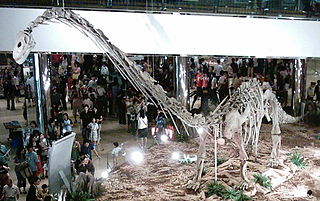
Omeisaurus is a genus of sauropod dinosaur from the Middle Jurassic Period of what is now China. Its name comes from Mount Emei, where it was discovered in the lower Shaximiao Formation of Sichuan Province.
Bashunosaurus is a genus of potentially macronarian sauropod dinosaur from the Middle Jurassic Shaximiao Formation of Kaijiang, China. The type and only species is Bashunosaurus kaijiangensis.

Szechuanosaurus is an extinct genus of carnivorous theropod dinosaur from the Late Jurassic. Fossils referred to the genus have been found in China, Asia in the Oxfordian-?Tithonian. Its type species is based on several undiagnostic teeth from the Kuangyuan Series. Additional possible specimens of Szechuanosaurus were also reported from the Kalaza Formation, also located in China.

Chienkosaurus is a dubious genus of carnivorous theropod dinosaur from the Late Jurassic Kuangyuan Series of China. It was probably related to Szechuanosaurus.
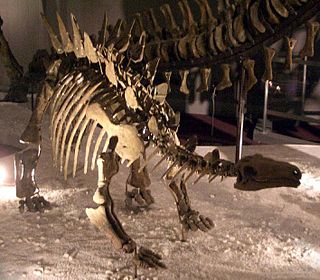
Chungkingosaurus, meaning "Chongqing Lizard", is a genus of herbivorous dinosaur from the Late Jurassic Upper Shaximiao Formation in what is now China. It is a member of the Stegosauria.
Gongbusaurus is a genus of ornithischian, perhaps ornithopod, dinosaur that lived between about 160 and 157 million years ago, in the Late Jurassic period. A small herbivore, it is very poorly known. Two species have been assigned to it, but as the original name is based on teeth, there is no concrete evidence to connect the two species. Its fossils have been found in China.
The Ziliujing Formation is a geological formation in China, It is Early Jurassic in age. It is part of the stratigraphy of the Sichuan Basin. The dinosaur Gongxianosaurus and indeterminate theropod material are known from the Dongyuemiao Member of the formation, as well as dinosaur footprints, Zizhongosaurus and indeterminate prosauropods from the Da'anzhai Member. The basal sauropod Sanpasaurus is known from the Maanshan Member. An unnamed stegosaur and the pliosauroid plesiosaur Sinopliosaurus are also known from this formation but they were found an indeterminate member. An unnamed teleosaurid known from a complete skull has also been found in the formation, pending a formal description. The deposition environment during the Da'anzhai Member in the lower Toarcian is thought to have been that of a giant freshwater lake encompassing the whole of the Sichuan basin, around 3 times larger than Lake Superior, coeval with the Toarcian Oceanic Anoxic Event around 183 Ma.
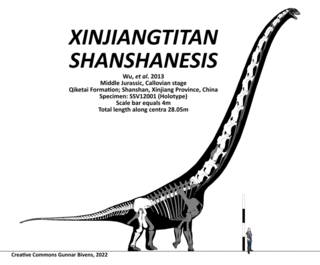
Xinjiangtitan is an extinct genus of mamenchisaurid sauropod that lived during the Middle Jurassic of what is now Xinjiang, northwestern China. Its type and only species is Xinjiangtitan shanshanesis, known from a single incomplete skeleton recovered from the Qiketai Formation. The holotype preserves one of the most complete vertebral columns of any sauropod found in Asia, and has the longest complete neck known for any animal.

Bashanosaurus is an extinct genus of stegosaurian dinosaur from the Middle Jurassic Shaximiao Formation of Yunyang County, China. The genus contains a single species, Bashanosaurus primitivus, known from incomplete skeletons belonging to three individuals. It is one of the basalmost stegosaurs, as well as one of the oldest known stegosaurs, along with Adratiklit, Isaberrysaura, and Thyreosaurus.

























